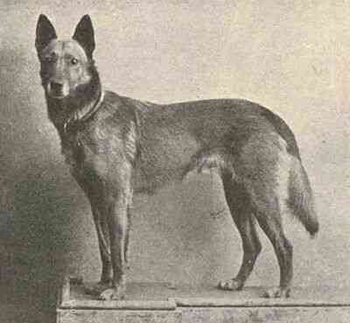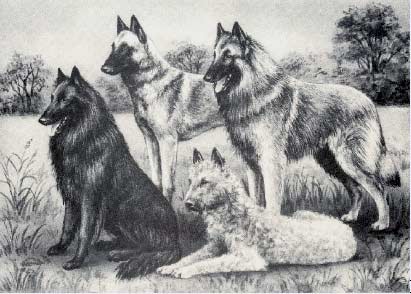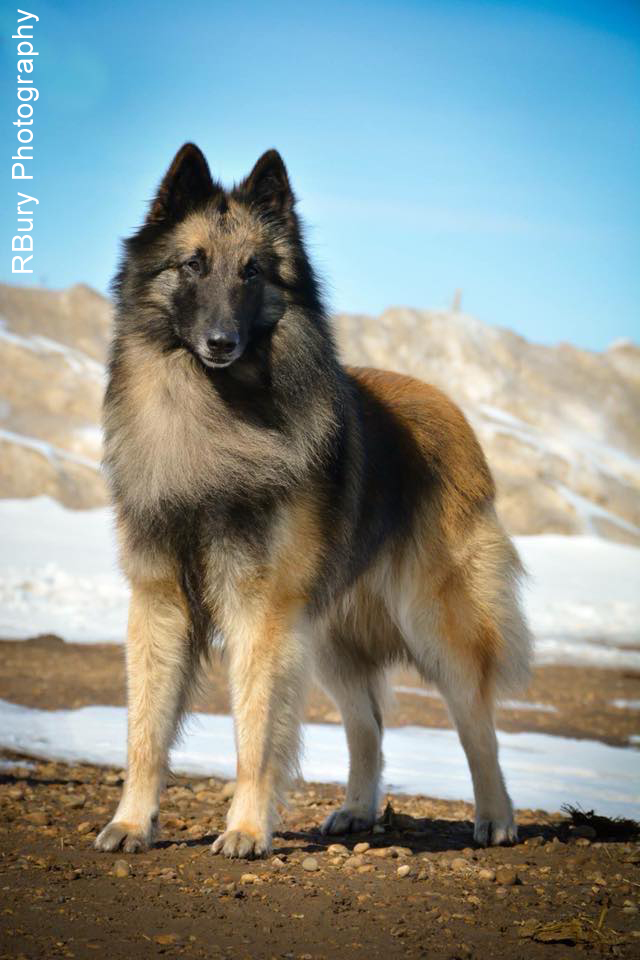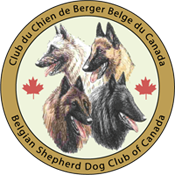Historical summary
How Did The Breed Develop?
The Belgian Shepherd Dog originated as a herding dog in Belgium. At the end of the 19th century, steps were taken to standardize the breed. Admirers found it relatively easy to agree upon the basic characteristics and qualities of the sheep herding dogs of Belgium, traits which form the fundamentals of today’s breed standard and reflect the Belgian’s origins as a working dog.
 The Belgian is a square-bodied, medium-boned dog that combines strength and agility while exhibiting the alertness, intelligence and trainability required of herding dogs. It is strong enough to serve as an actual protector of the flock, yet agile enough to make the sudden turns required of a herder. Sheep herding is a demanding, tiring task, and Belgians are built to move with efficient, almost effortless, ease. Because their movement is fluid and because by nature they love to move, Belgians are seemingly tireless, capable of working all day, day after day.
The Belgian is a square-bodied, medium-boned dog that combines strength and agility while exhibiting the alertness, intelligence and trainability required of herding dogs. It is strong enough to serve as an actual protector of the flock, yet agile enough to make the sudden turns required of a herder. Sheep herding is a demanding, tiring task, and Belgians are built to move with efficient, almost effortless, ease. Because their movement is fluid and because by nature they love to move, Belgians are seemingly tireless, capable of working all day, day after day.
In addition to the functional traits associated with their origins as Shepherd Dogs, Belgians are noted for their distinctly regal carriage. The Belgian’s head is essentially triangular, with a chiselled muzzle and small to medium sized prick ears. When at attention, a Belgian will arch its neck, giving it a majestic look.
Why Are There Different Varieties?
 When the breed was first standardized in Belgium in the 1890s, there was general agreement that the coat should be suitable for a dog working in the field and impervious to the vagaries of the Belgian climate. The one area of controversy involved coat length, texture and colour. Since the prototypes of the breed had been bred for their working ability, their coats were of little importance, provided it was functional. As a result, there was considerable diversity not only in colour but also in length and texture. Ultimately, the early standardizers of the breed agreed on three types of coat: long, short and rough.
When the breed was first standardized in Belgium in the 1890s, there was general agreement that the coat should be suitable for a dog working in the field and impervious to the vagaries of the Belgian climate. The one area of controversy involved coat length, texture and colour. Since the prototypes of the breed had been bred for their working ability, their coats were of little importance, provided it was functional. As a result, there was considerable diversity not only in colour but also in length and texture. Ultimately, the early standardizers of the breed agreed on three types of coat: long, short and rough.
The matter of coat colour presented more problems. Colours included solid black, fawn tipped with black, silver or grey tipped with black, brindle, and solid fawn. Certain combinations of coat type and colour were popular in different areas of Belgium and, in time, dogs of a particular type and colour were named for a town in the area where they were especially popular.
 Thus, the long-haired solid black is a Groenendael; the long-haired fawn tipped with black is a Tervuren; the short-haired fawn tipped with black is a Malinois; and the rough-haired fawn or grey is a Laeken.
Thus, the long-haired solid black is a Groenendael; the long-haired fawn tipped with black is a Tervuren; the short-haired fawn tipped with black is a Malinois; and the rough-haired fawn or grey is a Laeken.
The Fedération Cynologique Internationale, which governs purebred dog breeding and showing in many countries, including Belgium, currently recognizes three acceptable coat types: long-haired, short-haired and rough-haired. Within those groupings, the varieties are:
Groenendael: long-haired solid black;
Tervuren: long-haired fawn or grey with black overlay and black mask;
Malinois: short-haired fawn with black overlay and black mask; and
Laeken: rough-haired fawn with traces of black overlay, mainly on the muzzle and tail.
In Canada, the Canadian Kennel Club recognizes four major varieties of Belgians: the Groenendael, Tervuren, Malinois and Laeken.
Belgians in North America
Belgians were first introduced to North America by returning soldiers who had seen the breed overseas during World War I. Although several Belgians were imported at that time and even shown in the breed ring, the breed did not become firmly established in North America and had to be, in effect, re-introduced after World War II. Ironically, the two World Wars, which were so hard on the Belgian Shepherd Dogs in Belgium and France, were also responsible for introducing North Americans to this special breed. Gradually, in the late 40s and the 50s, Belgians became more widely known in both Canada and the United States.
Is the Breed the Same in the United States?
 When Belgians were first recognized by the American Kennel Club (AKC), the different varieties were recognized as sub-groups within one breed. In the years immediately following World War II, the Groenendael variety was the most popular and, when a Belgian Shepherd Dog was shown, it tended to be a Groenendael. In the mid 50s, Belgians of the Tervuren variety started to be shown.
When Belgians were first recognized by the American Kennel Club (AKC), the different varieties were recognized as sub-groups within one breed. In the years immediately following World War II, the Groenendael variety was the most popular and, when a Belgian Shepherd Dog was shown, it tended to be a Groenendael. In the mid 50s, Belgians of the Tervuren variety started to be shown.
In 1959, the AKC decided to split the breed and recognize the varieties as separate breeds. Because for many years the Groenendael had been virtually the only variety shown under the name “Belgian Sheepdog,” the Groenendael was associated with that name. Thus, when splitting the breed, the AKC gave the Groenendael the generic name of “Belgian Sheepdog.” The Tervuren variety became the “Belgian Tervuren” breed, and the Malinois variety became the “Belgian Malinois” breed. After 1959, the AKC no longer recognized the Laeken variety. However, in recent years, dedicated fanciers have worked hard to gain status for this variety, first in the AKC Miscellaneous Group and then, beginning in August 2020, in the Herding Group as the “Belgian Laekenois” breed.
Canada, in accordance with the practice in Belgium and almost all other countries, recognizes only one breed - the “Belgian Shepherd Dog” - which includes the four varieties (Groenendael, Laeken, Malinois and Tervuren).
Belgians in Canada
 Belgians had been bred, owned and shown in Canada for many years already when a group of 19 Belgian fanciers met in Thorold, Ontario in June 1964. The group formed the Belgian Sheepdog Club of Canada, later renamed the Belgian Shepherd Dog Club of Canada (BSDCC), to “foster and promote the best interests of the breed.”
Belgians had been bred, owned and shown in Canada for many years already when a group of 19 Belgian fanciers met in Thorold, Ontario in June 1964. The group formed the Belgian Sheepdog Club of Canada, later renamed the Belgian Shepherd Dog Club of Canada (BSDCC), to “foster and promote the best interests of the breed.”
When the BSDCC was formed, the centre of activity for the breed in Canada was in southern Ontario. Belgian Shepherds can now be found in most provinces. Any area with sufficient interest in Belgians can form a Section of the national club. The Sections enjoy considerable autonomy, electing their own officers and directing their own activities, such as fun days and walks, training workshops in a range of dog sports, regional specialties, herding, agility, obedience or rally trials, tracking tests, and more, depending on the interests of the Section’s members. The Sections work under the direction and guidance of the national Club; members join the national Club and, if they live in an area where there is a Section, they automatically become members of that Section.

